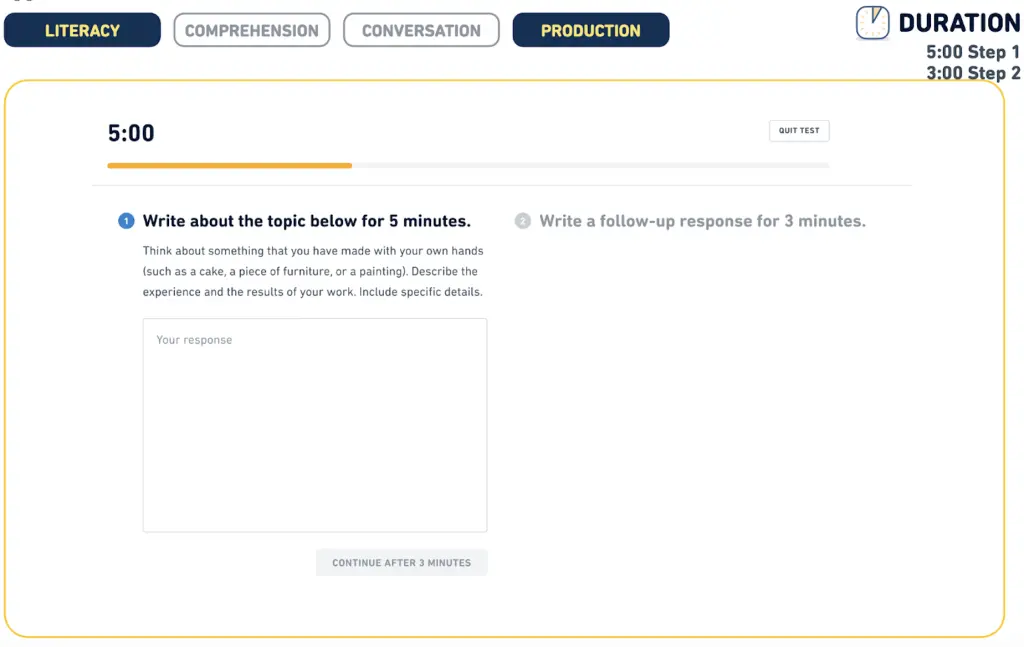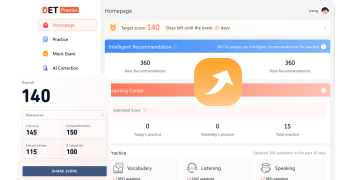Mastering the New Interactive Writing Question Type in Duolingo English Test 2024
The Duolingo English Test introduces a new question type called Interactive Writing in April 2024. Mastering this question type is crucial for achieving a higher writing score. In this post, we’ll explore the structure of the Interactive Writing question, and strategies for answering it effectively, and provide you with templates and sample answers to help you succeed.
If you want to get more templates and information, you can watch the video below.
Understanding the Interactive Writing Question Structure

The Interactive Writing question consists of two parts. First, you’ll be given a writing prompt and 5 minutes to compose your response. Based on your answer, a second prompt will be generated, and you’ll have 3 minutes to continue writing according to the new prompt’s requirements. The question interface will look similar to the screenshot provided earlier.
Types of Writing Questions in Duolingo English Test
The writing questions in the Duolingo English Test can be categorized into three main types:
1. Descriptive questions
2. Argumentative questions (including opinion-based questions)
3. Comparative questions
By mastering writing structures tailored to each question type, you can significantly improve your performance in the writing sections.
Strategies for Answering Interactive Writing Questions
Let’s analyze a sample question and prompt:
When should children begin learning a foreign language? Why? Give specific reasons for your answer.
This is an opinion-based question, and we can use one of two templates to answer it effectively.
Template 1:
· Start with your stance: “I firmly believe that [your stance]”
· Elaborate with a reason: “One primary reason for this is [your reason(s)]”
· Provide an example or evidence: “For instance, [your example]”
· Conclude by reinforcing your stance: “Therefore, [your stance].”
Template 2:
· Present a balanced view: “While some might argue that [counter-argument], I believe that [your stance].”
· Justify your stance: “This is mainly due to [reason].”
· Illustrate with an example: “A notable example is [example]”
· Sum up your argument: “In conclusion, despite [counter-argument], I believe that [your stance].”
Using Template 1, a sample answer might look like this:
“I firmly believe that children should begin learning a foreign language as early as possible, ideally before age 5. One primary reason for this is that young children’s brains have a remarkable capacity to absorb new languages quickly. The earlier they are exposed to a second language, the more easily they can attain native-like pronunciation and internalize the language’s structure and patterns. For instance, research has shown that children who start learning a language before age 7 are far more likely to achieve high proficiency than those who start as teenagers or adults. Therefore, I believe starting foreign language education in early childhood gives kids the best shot at becoming fluent.”
Handling the Second Writing Prompt
Based on your response to the first prompt, you might encounter a second prompt like this:
What would you say to those who argue that early childhood foreign language education detracts from other crucial areas of learning and development?
This is an argumentative question, and we can use Template 2 to address it. However, since we only have 3 minutes to respond, we can streamline the template by omitting the final summary step.
A sample answer using the modified Template 2:
While some might argue that early foreign language learning hinders other crucial development, I believe that it enhances overall cognitive abilities. This is mainly due to the brain’s increased flexibility and capacity to acquire multiple languages simultaneously during early childhood. A notable example is the success of immersion programs which demonstrate that children can learn languages and thrive academically in other subjects.
Additional Resources
For more information on the Interactive Writing question type, consult the latest Official Guide. If you’re looking for more writing tips and practice, visit our Blog and Course pages.
Conclusion
By understanding the structure of the Interactive Writing question type, utilizing the provided templates, and practicing with sample questions, you’ll be well-prepared to tackle this new challenge in the Duolingo English Test 2024. Good luck with your exam!
Further Reading:
DET Prep Course: Interactive Writing
(An article about preparing for the Interactive Writing section of the Duolingo English Test.)
Duolingo English Test Speaking Practice: A Step-by-Step Improvement Guide
(An article about a comprehensive guide to the speaking section of the Duolingo English Test.)






